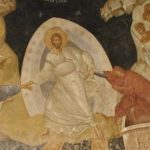CAN ONE BE INFECTED WITH A VIRUS FROM HOLY COMMUNION?
Translated by Seraphim Larin
With regard to the coronavirus epidemic, the MP Synod has issued the following edict concerning the partaking of Holy Communion by the laity:
1. After every serving of Christ’s Holy Mystery, the spoon is to be wiped with a hand cloth impregnated with alcohol (with regular refreshment), and then immersed in water, which should be disposed of in the same way as in the accepted washing practice of hand cloths.
2. To offer the after-Communion drink to the communicant in individual dispensable cups.
3. Disposable hygienic gloves are to be used in the distribution of the “antidor”.
4. The use of hand cloths during Holy Communion is restricted for the protection of the Holy Host in case of spillage to the floor, and for wiping the spoon. Wiping of individual lips of communicants should be done with paper napkins, followed by and their destruction by fire. Hand cloths to be boiled and washed with due reverence after every Liturgical use.
5. Communicants must refrain from kissing the chalice.
This directive aroused a justifiable indignation from Christian zealous adherents within the Moscow Patriarchate. In response to the zealots met. Hilarion (Alfeev) issued a video appeal, in which he defends this Synodal decree as being in conformity with the traditions of the Church, in case of an epidemic.
Firstly, he is presenting the interpretation of St. Nicodemus the Hagiorite of the 28th Canon of the Sixth Ecumenical Council, in which St. Nikodemus says the following:
“For giving Holy Communion to the sick during pestilence, Bishops and Priests must apply the following procedure: to place the Holy Gifts into some blessed vessel… from which the sick, or those attending to them, must take from a spoon. The vessel and the spoon must be immersed in an acetous liquid, and this liquid emptied into an altar drywell or some other safe place”.
Met. Hilarion also cites the “Handbook for the Clergy” by S. Bulgakov, in which it ascribes the following precautions during Holy Communion of sick children and those with infectious illnesses (e.g. diphtheria, smallpox): not to bring the sick children to church for Communion, or communicate them after the healthy participants: then wipe the spoon as well as the lips of the sick child with a special cloth, destroying it by fire after Communion”. (Ed.1913, page 1131).
With regard to S. Bulgakov’s “Handbook”, it must be noted that its directive is based on the prescriptions of the Clerical Consistories. During the Synodal period, the Russian Church was one of the government departments and the prescriptions of the spiritual authorities, went in accord with the prescriptions of the civil authorities, which were not always in agreement with the Church tradition. For example, during the cholera epidemic, the Synod ordered the boiling of water before it was blessed on the Feast Day of Theophany. Understandably, such directives evoked great protests from the zealous priests.
Incidentally, in the same “Handbook”, there is an expressed opinion by the Kharkov Consistory, which agrees with: “The application of special spoons in communicating the sick, is a step that doesn’t conform to the meaning of the Holy Mystery of Eucharist…” (Page 1131).
Obviously, the examples which met. Hilarion is referring to, deal with giving Holy Communion to the known sick, and not to change the general practice of Holy Communion during an epidemic.
In the life of Saint John of Shanghai, there was the following occasion: The Saint gave Holy Communion to a woman sick with rabies, who spat out the Holy Host. The Saint immediately picked up the particle of Christ’s Body and swallowed it. Those present were horrified, but Saint John suffered no harm.
As the Lord states in the Holy Gospel: “These signs will accompany those who have believed … And if they drink anything deadly, it will by no means hurt them”. (Mark 16:18).
However, not everyone can have the faith of Saint John. For the priest and laity, it would be frightening to have Holy Communion from the same chalice and spoon, in which an infected person had communed. The prescriptions which met. Hilarion cites, are essential not for the purpose of shielding the communicants from the disease, but through the condescension to the frailty of their faith: so that they may have Communion with a calm conscience and not with fear, and so that no one began to avoid Holy Communion because of fear of being infected.
To demand that the laity accept Holy Communion from a spoon, which was given to a sick person, would mean pressing upon them an unbearable weight on their conscience. This would mean compelling them to have Holy Communion with fear and revulsion.
In any case, the examples that have been advanced by met. Hilarion speak of giving Holy Communion to the sick, and cannot in any way serve as a justification for a change in the general order and practice of Holy Communion that has been introduced by the MP Synod. This new practice implies implicitly that the Holy Mystery may be a source of a disease. This practice exposes a lack of faith in the performers of this Mystery and rightly evokes protests from the ardent faithful.
Of course, one could object and say that among the mass of seemingly healthy people, there could be one carrier of the disease, from whom others could be infected. But didn’t such similar danger exist in the past? Didn’t such infectious diseases exist in the past? Didn’t the Church have concerns for the health and welfare of Her children?
The practice of Holy Communion from one spoon has existed for hundreds of years. If this practice really transmitted infectious diseases, it would have been noticed a long time ago, and such a practice would have ceased. On the contrary. What has been noticed is that no such thing is happening, and the fear of infection through Holy Communion isn’t based on facts, but lack of faith.
Bishop Andrei









